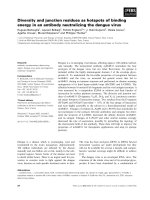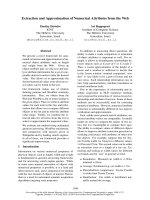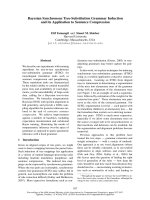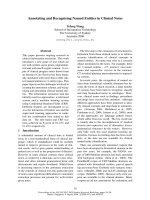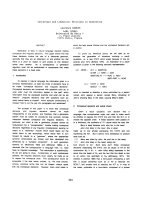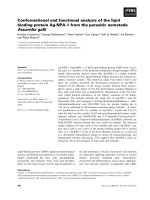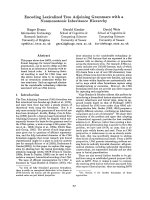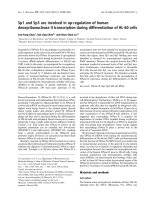Báo cáo khoa học: "LICENSING AND TREE ADJOINING GRAMMAR IN GOVERNMENT BINDING PARSING" pdf
Bạn đang xem bản rút gọn của tài liệu. Xem và tải ngay bản đầy đủ của tài liệu tại đây (437.01 KB, 8 trang )
LICENSING AND TREE ADJOINING GRAMMAR IN
GOVERNMENT BINDING PARSING
Robert Frank*
Department of Computer and Information Sciences
University of Pennsylvania
Philadelphia, PA 19104
email: frank@ linc.cis.upenn.edu
Abstract
This paper presents an implemented, psychologically plau-
sible parsing model for Government Binding theory gram-
mars. I make use of two main ideas: (1) a generaliza-
tion of the licensing relations of [Abney, 1986] allows for
the direct encoding of certain principles of grammar (e.g.
Theta Criterion, Case Filter) which drive structure build-
ing; (2) the working space of the parser is constrained
to the domain determined by a Tree Adjoining Grammar
elementary tree. All dependencies and constraints are lo-
caiized within this bounded structure. The resultant parser
operates in linear time and allows for incremental semantic
interpretation and determination of grammaticaiity.
1 Introduction
This paper aims to provide a psychologically plausible
mechanism for putting the knowledge which a speaker
has of the syntax of a language, the competence gram-
mar, to use. The representation of knowledge of language
I assume is that specified by Government Binding (GB)
Theory introduced in [Chomsky, 1981]. GB, as a com-
petence theory, emphatically does not specify the nature
of the language processing mechanism. In fact, "proofs"
that transformational grammar is inadequate as a linguis-
tic theory due to various performance measures are funda-
mentally flawed since they suppose a particular connection
between the grammar and parser [Berwick and Weinberg,
1984]. Nonetheless, it seems desirable to maintain a fairly
direct connection between the linguistic competence and
*I would like to thank the following for their valuable discussion and
suggestions: Naoki Fukui, Jarnie Henderson, Aravind Joshi, Tony Kroch,
Mitch Marcus, Michael Niv, Yves Schabes, Mark Steedman, Enric Vall-
duv{. This work was pa~ially supported by ARO Grants DAAL03-89-
C0031 PRI and DAAG29-84-K-0061 and DARPA grant
N00014-85-K-
0018. The author is supported by a Unisys doctoral fellowship.
its processing. Otherwise, claims of the psychological re-
ality of this particular conception of competence become
essentially vacuous since they cannot be falsified but for
the data on which they are founded, i.e. grammaticality
judgments. Thus, in building a model of language pro-
cessing, I would like to posit as direct a link as is possible
between linguistic competence and the operations of the
parser while still maintaining certain desirable computa-
tional properties.
What are the computational properties necessary for
psychological plausibility? Since human syntactic pro-
cessing is an effortless process, we should expect that it
take place efficiently, perhaps in linear time since sen-
tences do not become more difficult to process simply
as a function of their length. Determinism, as proposed
by Marcus [1980], seems desirable as well. In addition,
the mechanism should operate in an incremental fashion.
Incrementality is evidenced in the human language pro-
cessor in two ways. As we hear a sentence, we build
up semantic representations without waiting until the sen-
tence is complete. Thus, the semantic processor should
have access to syntactic representations prior to an utter-
ance's completion. Additionally, we are able to perceive
ungrammaticality in sentences almost immediately after
the ill fonnedness occurs. Thus, our processing mecha-
nism should mimic this early detection of ungrammatical
input.
Unfortunately, a parser with the most transparent rela-
tionship to the grammar, a "parsing as theorem proving"
approach as proposed by [Johnson, 1988] and [Stabler,
1990], does not fare well with respect to our computa-
tional desiderata. It suffers from the legacy of the com-
putational properties of first order theorem proving, most
notably undecidability, and is thus inadequate for our pur-
poses. The question, then, is how much we must repeat
from this direct instantiatiou so that we can maintain the
requisite properties. In this paper, I attempt to provide
iii
an answer. I propose a parsing model which represents
the principles of the grammar in a fairly direct manner,
yet preserves efficiency and incrementality. The model
depends upon two key ideas. First, I utilize the insight
of [Abney, 1986] in the use of
licensing relations as the
foundation for GB parsing. By generalizing Abney's for-
mulation of licensing, I can directly encode and enforce
a particular class of the principles of GB theory and in
so doing efficiently build phrase structure. The principles
expressible through licensing are not all of those posited
by GB. Thus, the others must be enforced using a different
mechanism. Unfortunately, the unbounded size of the tree
created with licensing makes any such mechanism compu-
tationally abhorrent. In order to remedy this, I make use
of the Tree Adjoining Grammar (TAG) framework [Joshi,
1985] to limit the working space of the parser. As the
parser proceeds, its working slructure is bounded in size.
If this bound is exceeded, we reduce this structure by one
of the operations provided by the TAG formalism, either
substitution or adjunction. This results in two structures,
each of which form independent elementary trees. Inter-
estingly, the domain of locality imposed by a TAG ele-
mentary tree appears to be sufficient for the expression of
the remaining grammatical principles. Thus, we can check
for the satisfaction of the remaining grammatical princi-
ples in just the excised piece of structure and then send it
off for semantic interpretation. Since this domain of con-
straint checking is bounded in size, this process is done
efficiently. This mechanism also works in an incremental
fashion.
2 Abney's Licensing
Since many grammatical constraints are concerned with
the licensing of elements, Abney [1986] proposes utiliz-
ing licensing structure as a more concrete representation
for parsing. This allows for more efficient processing yet
maintains "the spirit of the abstract grammar."
Abney's notion of licensing requires that every element
in a structure be licensed by performing some syntac-
tic function. Any structure with unlicensed elements is
ill-formed. Abney takes them role assignment to be the
canonical case of licensing and assumes that the properties
of a general licensing relation should mirror those of theta
assignment, namely, that it be
unique, local
and
lexical.
The uniqueness proporty for them assignment requires that
an argument receives one and only one them role. Corre-
spondingly, licensing is unique: an element is licensed via
exactly one licensing relation. Locality demands that theta
assignment, and correspondingly licensing, take place un-
der a strict definition of government: sisterhood. Finally,
112
IP
NP will vpSM~
M ry tomorrow
~T ~
Figure 1: Abney's Licensing Relations in Clausal Struc-
ture (S = subjecthood, F = functional selection, M = mod-
ification, T = theta)
theta assignment is lexical in that it is the properties of the
the theta assigner which determine what theta assignment
relations obtain. Licensing will have the same property; it
is the licenser that determines how many and what sort of
elements it licenses.
Each licensing relation is a 3-tuple
(D, Cat, Type). D
is
the direction in which licensing occurs.
Cat
is the syntac-
tic category of the element licensed by this relation.
Type
specifies the linguistic function accomplished by this li-
censing relation. This can be either
functional selection,
subjecthood, modification or theta-assignment.
Functional
selection is the relation which obtains between a func-
tional head and the element for which it subcategorizes,
i.e. between C and IP, I and VP, D and NP. Subjecthood
is the relation between a head and its "subject". Moditica-
tion holds between a head and adjunct. Theta assignment
occurs between a head and its subeategnrized elements.
Figure 1 gives an example of the licensing relations which
might obtain in a simple clause. Parsing with these li-
censing relations simply consists of determining, for each
lexieal item as it is read in a single left to right pass,
where it is licensed in the previously constructed structure
or whether it licenses the previous structure.
We can now re-examine Abney's claim that these licens-
ing relations allow him to retain "the spirit of the abstract
grammar." Since licensing relations talk only of very lo-
cal relationships, that occurring between sisters, this sys-
tem cannot enforce the constraints of binding, control, and
ECP among others. Abney notes this and suggests that his
licensing should be seen as a single module in a parsing
system. One would hope, though, that principles which
have their roots in licensing, such as those of theta and
case theory, could receive natural treatments. Unfortu-
nately, this is not true. Consider the theta criterion. While
this licensing system is able to encode the portion of the
constraint that requires theta roles to be assigned uniquely,
it fails to guarantee that all NPs (arguments) receive a theta
role. This is crucially not the case since NPs are some-
times licensed not by them but by subject licensing. Thus,
the following pair will be indistinguishable:
i. It seems that the pigeon is dead
ii. * Joe seems that the pigeon is dead
Both
It and Joe
will be appropriately licensed by a subject
licensing relation associated with
seems. The case
filter
also cannot be expressed since objects of ECM verbs are
"licensed" by the lower clause as subject, yet also require
case. Thus, the following distinction cannot accounted for:
i. Carol asked Ben to swat the fly
ii. * Carol tried Ben to swat the fly
Here, in order to get the desired syntactic structure (with
Ben
in the lower clause in both cases),
Ben
will need to
be licensed by the inflectional element
to.
Since such a
licensing relation need be unique, the case assigning prop-
erties of the matrix verbs will be irrelevant. What seems
to have happened is that we have lost the modularity of the
the syntactic relations constrained by grammatical princi-
ples. Everything has been conltated onto one homoge-
neous licensing structure.
3 Generalized Licensing
In order to remedy these deficiencies, I propose a system
of
Generalized Licensing.
In this system, every node is
assigned two sets of licensing relations:
gives and needs.
Gives are similar to the Abney's licensing relations: they
are satisfied locally and determined lexically. Needs spec-
ify the ways
in
which a node must be licensed.1 A need
of type them, for example, requires a node to be licensed
by a theta relation. In the current formulation, needs differ
from gives in that they are always directionaUy unspeci-
fied. We can now represent the theta criterion by placing
theta gives on a theta assigner for each argument and theta
needs on all DPs. This encodes both that all them roles
must be assigned and that all arguments must receive theta
roles.
In Generalized Licensing, we allow a greater vocabu-
lary of relation types: case, them assignment, modification,
functional selection, predication, f-features, etc. We can
then explicitly represent many of the relations which are
posited in the grammar and preserve the modularity of the
theory. As a result, however, certain elements can and
must be multiply licensed. DPs, for instance, will have
needs for both them and case as a result of the case filter
and theta criterion. We therefore relax the requirement that
1These bear some similarity to the anti-relations of Abney, but are
used in
a rather different fashion.
113
all nodes be uniquely licensed. Rather, we demand that
all gives and needs be uniquely "satisfied." The unique-
ness requirement in Abney's relations is now pushed down
to the level of individual gives and needs. Once a give
or need is satisfied, it may not participate in any other
licensing relationships.
One further generalization which I make concerns the
positioning of gives and needs. In Abney's system, licens-
ing relations are associated with lexical heads and applied
to maximal projections of other heads. Phrase structure is
thus entirely parasitic upon the reconstruction of licensing
structure. I propose to have an independent process of
lexical projection. A lexical item projects to the correct
number of levels in its maximal projection, as determined
by theta structure, f-features, and other lexical properties. 2
Gives and needs are assigned to each of these nodes. As
with Abney's system, licensing takes place under a strict
notion of government (sisterhood). However, the projec-
tion process allows licensing relations determined by a
head to take place over a somewhat larger domain than
sisterhood to the head. A DP's theta need resulting from
the them criterion, for example, is present only at the max-
imal projection level. This is the node which stands in the
appropriate structural relation to a theta give. As a re-
sult of this projection process, though, we must explicitly
represent structural relations during parsing.
The reader may have noticed that multiple needs on a
node might not all be satisfiable in one structural position.
Consider the case of a DP subject which possesses both
theta and case needs. The S-structure subject of the sen-
tence receives its theta role from the verb, yet it receives its
case from the tense/agreement morpheme heading IP. This
is impossible, though, since given the structural correlate
of the licensing relation, the DP would then be directly
dominated both by IP and by VP. Yet, it cannot be in ei-
ther one of these positions alone, since we will then have
unsatisfied needs and hence an ill-formed structure. Thus,
our representation of grammatical principles and the con-
straints on give and need satisfaction force us into adopt-
ing a general notion of chain and more specifically the VP
internal subject hypothesis. A chain consist of a list of
nodes (al ,a~) such that they share gives and needs and
each ai c-commands each a~+l. The first element in the
chain, al, the head, is the only element which can have
phonological content. Others must be empty categories.
Now, since the elements of the chain can occupy differ-
ent structural positions, they may be governed and hence
licensed by distinct elements. In the simple sentence:
[IP Johns tns/agr [V' ti smile]]
21 assume the relativized X-bar theory proposed in [Fukui and Speas,
1986].
the trace node which is an argument of
smile
forms a chain
with the DP
John.
In its V' internal position, the theta
need is satisfied by the theta give associated with the V.
In subject position, the case need is satisfied by the case
give on the I' projection of the inflectional morphology.
Now, how might we parse using these licensing rela-
tions? Abney's method is not sufficient since a single
instance of licensing no longer guarantees that all of a
node's licensing constraints are satisfied. I propose a sim-
ple mechanism, which generalizes Abney's approach: We
proceed left to right, project the current input token to its
maximal projection p and add the associated gives and
needs to each of the nodes. These are determined by ex-
amination of information in the lexical entries (such as
using the theta grid to determine theta gives), examination
of language specific parameters (using head directionality
in order to determined directionality of gives, for exam-
pie), and consultation of UG parameters (for instance as a
result of the case filter, every DP maximal projection will
have an associated case need). The parser then attempts to
combine this projection with previously built structure in
one of two ways. We may attach p as the sister of a node
n on the right frontier of the developing structure, when
p is licensed by n either by a give in n and/or a need in
the node p. Another possibility is that the previously built
structure is attached as sister to a node, rn, dominated by
the maximal projection p, by satisfying a give in rn and/or
a need on the root of the previously built structure. In the
case of multiple attachment possibilities, we order them
according to some metric such as the one proposed by
Abney, and choose the most highly ranked option.
As structure is built, nodes in the tree with unsatisfied
gives and needs may become closed off from the right
frontier of the working structure. In such positions, they
will never become satisfied. In the ease of a need in an
internal node n which is unsatisfied, we posit the existence
of an empty category rn, which will be attached later to
the structure such that (n,
ra)
form a chain. We posit an
element to have been moved into a position exactly when it
is licensed at that position yet its needs are not completely
satisfied. After positing the empty category, we push it
onto the
trace stack.
When a node has an unsatisfied give
and no longer has access to the right frontier, we must posit
some element, not phonologically represented in the input,
which satisfies that give relation. If there is an element on
the top of the trace stack which can satisfy this give, we
pop it off the stack and attach it. 3 Of course, if the trace
has any remaining needs, it is returned to the Pace stack
since its new position is isolated from the right frontier.
If no such element appears on top of the mace stack, we
3Note that the use of this stack to recover filler-gap structures forbids
non-nested dependencies as in [Fodor, 1978].
IP
/~ 8tree: <left, case, nomlaattve, 1>
i
needs: <th~, ?, ?> needs:
<caae, non~ative, ~>Harry ! styes: <rlsht, ~anctioc select, VP, ?>
Figure 2: Working Space after "Harry tns/agr"
posit a non-mace empty category of the appropriate type,
if one exists in the language. 4
Let's try this mechanism on the sentence "Harry
laughs." The first token received is Harry and is projected
to DP. No gives are associated with this node, but them
and case needs are inserted into the need set as a result
of the them criterion and the case filter. Next,
tns/agr
is
read and projected to
I",
since it possesses f-features (cf.
[Fuktti and Speas, 1986]). Associated with the I ° node
is a rightward functional selection give of value V. On
the I' node is a leftward nominative case give, from the
f-features, and a leftward subject give, as a result of the
Extended Projection Principle. The previously constructed
DP is attached as sister to the I' node, thereby satisfying
the subject and case gives of the I' as well as the case need
of the DP. We are thus left with the structure in figure 2. 5
Next, we see that the them need of the DP is inaccessible
from the right frontier, so we push an empty category DP
whose need set contains this unsatisfied theta need onto
the mace stack. The next input token is the verb
laugh.
This is projected to a single bar level. Since laugh assigns
an external theta role, we insert a leftward theta give to
a DP into the V' node. This verbal projection is attached
as sister to I °, satisfying the functional selection give of
I. However, the theta give in V' remains unsatisfied and
since it is leftward, is inaccessible. We therefore need to
posit an empty category. Since the DP trace on top of the
trace stack will accept this give, the trace stack is popped
and the trace is attached via Chomsky-adjunction to the
4Such a simplistic approach to determining whether a trace or non-
trace empty category should be inserted is dearly not correct. For in-
stance, in "tough movement"
Alvin i is tough PRO to feed ti
the proposed mechanism will insert the trace of
Alvin
in subject posi-
tion rather than PRO. It remains for future work to determine the exact
mechanism by which such decisions are made.
5In the examples which follow, gives are shown as 4-topics
(D,T~tpe,Val, SatBI/)
where D is the direction,
T~tpe
is the type
of licensing relation,
Val
is the licensing relation value and
SatB~
is
the node which satisfies the give (marked as 7, if the relation is as
yet
unsatisfied). Needs are 3-tuples
(Type, Val, SatB~/)
where these are
as in the gives. For purposes of readability, I remove previously satisfied
gives and needs from the fgure. Of course, such information persists in
the parser's representation.
114
IP
81ve~ o
Harry
need= ~
*~.eds: ,eh~,a, aS~, *,>
V
I
laush
Figure 4: Adjunction of auxiliary tree/~ into elementary
tree ~ to produce
7
Figure 3: Working space after "Harry tns/agr laugh"
V' node yielding the structure in figure 3. Since this node
forms a chain with the subject DP, the theta need on the
subject DP is now satisfied. We have now reached the end
of our input. The resulting structure is easily seen to be
well-formed since all gives and needs are satisfied.
We have adopted a very particular view of traces: their
positions in the structure must be independently motivated
by some other licensing relation. Note, then, that we can-
not analyze long distance dependencies through successive
cyclic movement. There is no licensing relation which will
cause the intermediate traces to exist. Ordinarily these
traces exist only to allow a well-formed derivation, i.e.
not ruled out by subjacency or by a barrier to antecedent
government. Thus, we need to account for constraints on
long distance movement in another manner. We will return
to this in the next section.
The mechanism I have proposed allows a fairly direct
encoding for some of the principles of grammar such as
case theory, them theory, and the extended projection prin-
ciple. However, many other constraints of GB, such as the
ECP, control theory, binding theory, and bounding the-
try, cannot be expressed perspicuously through licensing.
Since we want our parser to maintain a fairly direct con-
nection with the grammar, we need some additional mech-
anism to ensure the satisfaction of these constraints.
Recall, again, the computational properties we wanted to
hold of our parsing model: efficiency and incrementality.
The structure building process I have described has worst
case complexity
O(n 2)
since the set of possible attach-
ments can grow linearly with the input. While not enor-
mously computationally intensive, this is greater that the
linear time bound we desire. Also, checking for satisfac-
tion of non-licensing constraints over unboundedly large
structures is likely to be quite inefficient. There is also
the question of when these other constraints are checked.
To accord with incrementality, they must be checked as
soon as possible, and not function as post-processing "fil-
ters." Unfortunately, it is not easily determinable when a
given constraint can apply such that further input will not
change the status of the satisfaction of a constraint. We
do not want to rule a structure ungrammatical simply be-
cause it is incomplete. Finally, it is unclear how we might
incorporate this mechanism which builds an ever larger
syntactic structure into a model which performs semantic
interpretation incrementally.
4 Limiting the Domain with TAG
These problems with our model are solved if we can place
a limit on the size of the structures we construct. The
number of licensing possibilities would be bounded yield-
ing linear time for smacture construction. Also, constraint
checking could be done in a constant amount of process-
ing. Unfortunately, the productivity of language requires
us to handle sentences of unbounded length and thus lin-
guistic structures of unbounded size.
TAG provides us with a way to achieve this paradise.
TAG accomplishes linguistic description by factoring re-
cursion from local dependencies [Joshi, 1985]. It posits
a set of primitive structures, the
elementary trees,
which
may be combined through the operations of
adjunction
and
substitution.
An elementary tree is a minimal non-
recursive syntactic tree, a predication structure containing
positions for all arguments. I propose that this is the pro-
jection of a lexical head together with any of the associated
functional projections of which it is a complement. For
instance, a single elementary tree may contain the projec-
tion of a V along with the I and C projections in which it
is embedded. 6 Along the frontier of these trees may ap-
pear terminal symbols (i.e. lexical items) or non-terminals.
The substitution operation is the insertion of one elemen-
tary tree at a non-terminal of same type as the root on the
frontier of another elementary tree. Adjunction allows the
insertion of one elementary tree of a special kind, an aux-
iliary tree, at a node internal to another (cf. figure 4). In
6This
definition of TAG elementary trees is consistent with the Lex-
icalized TAG framework [Schabes
et al.,
1988] in that the lexical head
may be seen as the anchor of the elementary trees. For further details
and consequences of this proposal on elementary tree weU-fomaedness,
see [Frank, 1990].
115
auxiliary trees, there is a single distinguished non-terminal
on the frontier of the tree, the
foot node,
which is iden-
tical in type to the root node. Only adjunctions, and not
substitutions, may occur at this node.
TAG has proven useful as a formalism in which one can
express linguistic generalizations since it seems to provide
a sufficient domain over which grammatical constraints
can be stated [Kroch and Joshi, 1985] [Kroch and San-
torini, 1987]. Kroch, in two remarkable papers [1986] and
[1987], has shown that even constraints on long distance
dependencies, which intuitively demand a more "global"
perspective, can be expressed using an entirely local (i.e.
within a single elementary lee) formulation of the ECP
and allows for the collapsing of the CED with the ECP.
This analysis does not utilize intermediate traces, but in-
stead the link between filler and gap is "stretched" upon
the insertion of intervening structure during adjunctions.
Thus, we are relieved of the problem that intermediate
traces are not licensed, since we do not require their exis-
tence.
Let us suppose a formulation of GB in which all princi-
ples not enforced through generalized licensing are stated
over the local domain of a TAG elementary tree. Now,
we can use the model described above to create structures
corresponding to single elementary trees. However, we
restrict the working space of the parser to contain only a
single structure of this size. If we perform an attachment
which violates this "memory limitation," we are forced to
reduce the structure in our working space. We will do
this in one of two ways, corresponding to the two mech-
anisms which TAG provides for combining structure. Ei-
ther we will undo a substitution or undo an adjunction.
However, all chains are required to be localized in indi-
vidual elementary tree. Once an elementary tree is fin-
ished, non-licensing constraints are checked and it is sent
off for semantic interpretation. This is the basis for my
proposed parsing model. For details of the algorithm, see
[Frank, 1990]. This mechanism operates in linear time and
deterministically, while maintaining coarse grained (i.e.
clausal) incrementality for grammaticality determination
and semantic interpretation.
Consider this model on the raising sentence "Harry
seemed to kiss Sally." We begin as before with "Harry
tns/agr" yielding the structure in figure 2. Before we re-
ceive the next token of input, however, we see that the
working structure is larger than the domain of an elemen-
tary tree, since the subject DP constitutes an independent
predication from the one determined by the projection of
I. We therefore unsubstitute the subject DP and send it off
to constraint checking and semantic interpretation. At this
point, we push a copy of the subject DP node onto the
trace stack due to its unsatisfied theta need.
116
IP
~'~ ~ t~i
I'
.,.~ <am r. r> /"
J~
6iw~ <risht, funclima-sdea. VP, k> I
ux./aSr SiVm~ ~ ~
1P. r>
Figure 5: Working space after "Harry tus/agr seem"
IP
n~di: <lhela, ?, ?>
x I'
sirra: <rl~t, there, u',
t>
v ~' n~it
n~d.:e .~l ~sivm: P ~ Jm~,t'nma-m~ vP. r>
Figure 6: Working space after "Harry tns/agr seem to"
We continue with the verb
seem
which projects to V'
and attaches as sister to I satisfying the functional selec-
tion give yielding the structure in figure 5. There remains
only one elementary tree in working space so we need
not perform any domain reduction. Next,
to
projects to I'
since it lacks f-features to assign to its specifier. This is
attached as object of
seem as
in figure 6. At this point,
we must again perform a domain reduction operation since
the upper and lower clauses form two separate elementary
trees. Since the subject DP remains on the trace stack, it
cannot yet be removed. All dependencies must be resolved
withina single elementary tree. Hence, we must unadjoin
the structure recursive on I' shown in figure 7 leaving the
structure in figure 8 in the working space. This structure
is sent off for constraint checking and semantic interpreta-
tion. We continue with
kiss,
projecting and attaching it as
functionally selected sister of I and popping the DP from
the trace stack to serve as external argument. Finally, we
I'
/N
I V'
tns/agr V I'
I
Figure 7: Result of unadjunction
IP
/~, Stves: <le*%, subject, DP, i>
&,iv~ e DPii ]I
need.: ~
needs:
<theta, ?, ?> /
<l'~ht, funct ton-select,
i
to
VP, ?>
Figure 8: Working space after unadjunction
constrained, we might be able to retain the efficient nature
of the current model. Other strategies for resolving such
indeterminacies using statistical reasoning or hard coded
rules or templates might also be possible, but these con-
structs are not the sort of grammatical knowledge we have
been considering here and would entail further abstraction
from the competence grammar.
Another problem with the parser has to do with the
incompleteness of the algorithm. Sentences such as
IP
v,
V
DP
I
kiss
Figure 9: Working Structure after entire sentence
project and attach the DP Sally as sister of V, receiving
both them role and case in this position. This DP is unsub-
stituted in the same manner as the subject and is sent off
for further processing. We are left finally with the struc-
ture in figure 9, all of whose gives and needs are satisfied,
and we are finished.
This model also handles control constructions, bare in-
finitives, ECM verbs and binding of anaphors, modifica-
tion, genitive DPs and others. Due to space constraints,
these are not discussed here, but see [Frank, 1990].
5 Problems and Future Work
Boris knew that Tom ate lunch
will not be parsed even though there exist well-formed
sets of elementary trees which can derive them. The prob-
lem results from the fact that the left to right processing
strategy we have adopted is a bit too strict. The comple-
mentizer that will be attached as object of know, but Tom
is not then licensed by any node on the right frontier. Ul-
timately, this DP is licensed by the tns/agr morpheme in
the lower clause whose IP projection is licensed through
functional selection by C. Similarly, the parser would have
great difficulty handling head final languages. Again, these
problems might be solved using extra-grammatical de-
vices, such as the attention shifting of [Marcus, 1980] or
some template matching mechanism, but this would entail
a process of "compiling out" of the grammar that we have
been trying to avoid.
Finally, phonologically empty heads and head move-
ment cause great difficulties for this mechanism. Heads
play a crucial role in this "project and attach" scheme.
Therefore, we must find a way of determining when and
where heads occur when they are either dislocated or not
present in the input string at all, perhaps in a similar man-
ner to the mechanism for movement of maximal projec-
tions I have proposed above.
The parsing model which I have presented here is still
rather preliminary. There are a number of areas which will
require further development before this can be considered
complete.
I have assumed that the process of projection is en-
tirely determined from lexieal lookup. It is clear, though,
that lexical ambiguity abounds and that the assignment of
gives and needs to the projections of input tokens is not
determinate. An example of such indeterminacy has to do
with the assignment to argument maximal projections of
theta needs as a result of the them criterion. DPs need not
always function as arguments, as I have been assuming.
This problem might be solved by allowing for the state-
ment of disjunctive constraints or a limited form of paral-
lelism. If the duration of such parallelism could be tightly
6 Conclusion
In this paper, I have sketched a psychologically plausible
model for the use of GB grammars. The currently im-
plemented parser is a bit too simple to be truly robust,
but the general approach presented here seems promising.
Particularly interesting is that the computationally moti-
vated use of TAG to constrain processing locality pro-
vides us with insight on the nature of the meta-grammar
of possible grammatical constraints. Thus, if grammatical
principles are stated over such a bounded domain, we can
guarantee the existence of a perspicuous model for their
use, thereby lending credence to the cognitive reality of
this competence grammar.
117
References
[Abney, 1986] Steven Abney. Licensing and parsing. In
Proceedings of NELS 16, Amherst, MA.
[Berwick and Weinberg, 1984] Robert Berwick and Amy
Weinberg. The Grammatical Basis of Linguistic Per-
formance. MIT Press, Cambridge, MA.
[Chomsky, 1981] Noam Chomsky. Lectures on Govern-
ment and Binding. Foris, Dordrecht.
[Fodor, 1978] Janet D Fodor. Parsing strategies and con-
straints on transformations. Linguistic Inquiry, 9.
[Frank, 1990] Robert Frank. Computation and Linguistic
Theory: A Government Binding Theory Parser Using
Tree Adjoning Grammar. Master's thesis, University
of Pennsylvania.
[Fukui and Speas, 1986] Naoki
Fukui and Margaret Speas. Specifiers and projec-
tion. In Naold Fukui, T. Rappaport, and E. Sagey,
editors, MIT Working Papers in Linguistics 8, MIT
Department of Linguistics.
[Johnson, 1988] Mark Johnson. Parsing as deduction: the
use of knowledge of language. In The MIT Parsing
Volume, 1987-88, MIT Center for Cognitive Science.
[Joshi, 1985] Aravind Joshi. How much context-
sensitivity is required to provide reasonable structural
descriptions: tree adjoining grammars. In D. Dowty,
L. Kartunnen, and A. Zwicky, editors, Natural Lan-
guage Processing: Psycholinguistic, Computational
and Theoretical Perspectives, Cambridge University
Press.
[Kroch, 1986] Anthony Kroch. Unbounded dependencies
and subjacency in a tree adjoining grammar. In A.
Manaster-Ramer, editor, The Mathematics of Lan-
guage, John Benjamins.
[Kroeh, 1987] Anthony Kroch. Assymetries in long
distance extraction in a tree adjoining grammar.
manuscript, University of Pennsylvania.
[Kroch and Joshi, 1985] Anthony Kroch and Aravind
Joshi. The Linguistic Relevance of Tree Adjoining
Grammar. Technical Report MS-CS-85-16, Univer-
sity of Pennsylvania Department of Computer and
Information Sciences. To appear in Linguistics and
Philosophy.
[Kroch and Santorini, 1987] Anthony Kroch and Beatrice
Santorini. The derived constituent structure of the
118
west germanic verb raising construction. In R. Frei-
din, editor, Proceedings of the Princeton Conference
on Comparative Grammar, MIT Press, Cambridge,
MA.
[Marcus, 1980] Mitchell Marcus. A Theory of Syntactic
Recognition for Natural Language. MIT Press, Cam-
bridge, MA.
[Schabes et al., 1988] Yves Schabes, Anne Abeill6, and
Aravind K. Joshi. Parsing strategies with 'lexical-
ized' grammars: application to tree adjoining gram-
mars. In COLING Proceedings, Budapest.
[Stabler, 1990] Edward Stabler. Implementing govern-
ment binding theories. In Levine and Davis, ed-
itors, Formal Linguistics: Theory and Implementa-
tion. forthcoming.
